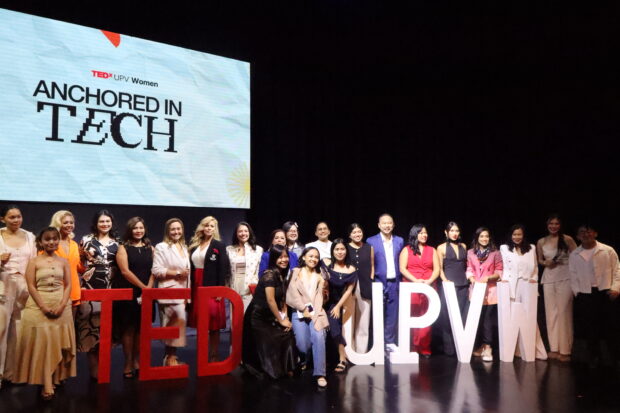EDWIN Wilwayco has taken a most dramatic shift in his abstract expressionism with his new “Fractals’ series of paintings.
After his “Bird of Paradise” and “Four Seasons,” series of works that took their inspiration from flora and clima, that is, from the most colorful and most musically resonant of nature’s phenomena, he has shifted to nature’s geometry, the materiality and mathematics of reality.
The result is an intriguing series of works that problematizes representation and gives art aficionados who champion his work an inkling on his creative process and the current state of his artistic mind.
His “geometric turn,” if we be permitted to call it that, is apparent in the title of the series.
“Fractal,” according to the Unabridged Webster’s Dictionary, is “a geometrical or physical structure having an irregular or fragmented shape at all scales of measurement between greatest and smallest scale such that certain mathematical or physical properties of the structure, as the perimeter of a curve or the flow rate in a porous medium, behave as if the dimensions of the structure (fractal dimensions) are greater than the spatial dimensions.”
Fractals are useful in modeling structures in which similar patterns recur at progressively smaller scales, such as coastlines, and in describing partly random phenomena such as crystal growth, fluid turbulence and galaxy formation.
A French word derived from the Latin “fract,” or broken, the geometric figure is useful for Wilwayco at this very mature stage of his artistic career, because it provides the governing metaphor, if not the trajectory with which, first, to limn or define his art by artistic “analysis,” which is to break down his art in order to see how the parts relate to the whole; and second, to enable him to tackle what is most critical today for a nature artist like him—the brokenness of the environment.
Commercial arts
At first blush, nature seems hardly the inspiration of “Fractals,” but rather sheer geometry, plastic design, and even commercial arts. There’s some truth to the claim of American art writer Josephine Fatima Martins in the exhibit catalogue that that the “source of inspiration and possibilities for ‘Fractals’ is contemporary fashion, home and architectural designs.”
It is noteworthy for one that the most ubiquitous icon in the series—the leopard spots—are a mainstay in design; one can see them in upholstery, women’s fashion, and even men’s underwear. But industrial-and-commercial design takes its most creative icons from the environment or from the history of artistic representation of nature.
Moreover, Wilwayco’s previous series have adapted themselves to the functional requirements of industrial design. Variants of the “Bird of Paradise,” for example, have been adapted into furniture. But while they assume forms of commercial design, they essentially remain artistic representations of nature. They bring the lines and colors of nature into the living room.
We mention the history of artistic representation because obviously Wilwayco considers himself along the line of abstract expressionists, whose pioneers saw themselves as inheritors or challengers of the traditions that came before them. And all artists worth their salt try to break new ground or at least, chart new directions for their art without however abandoning altogether the tradition that defined their art and style in the first place.
Wilwayco wouldn’t, for example, subscribe to much of contemporary or “postmodern” art’s declaration of the death of painting or, in the case of styles like his, of “Crapstraction.”
Modern tradition
To be sure, Wilwayco’s new series is along the line of Pollock’s action-paintings, Rothko’s “light-paintings,” Hofmann’s pictorialism and color relationships, and of course, Joya’s “tropicalism.” In contrast to many contemporary artists, Wilwayco modernist art tradition—his overall sense of history—is not puddle-deep.
“Fractal details” have been found in Pollock’s drip works, as Martins says. Wilwayco achieves those dimensions in the “Fractals” series which should be seen as such—as a series—so as to better guide viewers to the development of his art.
In the initial paintings, the leopard-spot as well as other icons—florals, geometrics—are directly shown and very visible. In later paintings, the spots and other patterns are obscured within spatial depth. In later groupings still, they seem to be erased, restored, and again, defaced and nearly obliterated. The effects are boldness of design and especially for the viewer, a sense of throbbing, kinetic space.
Much of the dynamism owes to the bold impastos, the gestural sweeps and style undercurrents, and even the erasures. The erasures provide an intriguing aspect to the works since they constitute the palimpsest that defines not only the push-and-pull, the trial-and-error crescendos of the creative process, but also the archival dynamics that establish the history of the work.
In short, the palimpsest points to the construction of “Fractals” and the series that came before it and which may have determined or given rise to the new series.
To some extent, “Fractals” is a practice in defamiliarization: it is a venture to seemingly new artistic terrain that is alien to those already familiar with the Wilwayco style.
Defamiliarization
Defamiliarization is a self-reflexive device for Wilwayco to raise the caveat that his art is after all a construction, that whatever its achievements in representing nature through abstraction may be, it is just a representation moored not on any one-to-one correspondence between reality and art, but on a system of codes and conventions that are tacitly agreed between artist and audience.
But “Fractals” doesn’t stop at defamiliarization. Contemporary artists invite attention to their art-making not out of critical self-awareness but because of self-absorption and their inherent spinelessness so that they can’t commit to anything outside of their narrow egos.
In contrast, defamiliarization is a Brechtian alienation effect that wakes the audience from their willing suspension of disbelief so that, alerted and aroused from the blissful lull they’ve been put into by the dramatic work before them, they can be impelled to critical action.
Therefore, by experimenting with “Fractals” and problematizing representation, Wilwayco realizes his second intention—to tackle in his practice the critical concern for the brokenness of nature.
It is noteworthy for one that fractals are used in modeling structures such as eroded coastlines or snowflakes, generally vanished landscapes. Many of these landscapes are in danger of sheer effacement and only through models of planning can they be restored or saved.
Effacement, extinction
Or will they be effaced again because planning and development are mere rearguard actions to save nature while in fact jettisoning or sacrificing it altogether in the name of progress and development? Do the erasures and the palimpsests in “Fractals” embody this push-and-pull, nay the Janus face, of liberal capitalism?
We must add here that the beautiful iconography of the leopard spots points to the danger of extinction facing animals which are poached and killed for their ivory tusks or their beautiful hides. Many of these animals are supposedly protected in wildlife preserves, but their situation becomes evermore precarious especially since their preserves obtain in very troubled hotspots. For example, the beautiful snow leopard’s endangered-species status is always heightened whenever we hear of the violence and chaos in Pakistan and Afghanistan.
Such evocations—nature’s beauty and bounty through art’s geometry and the dangers facing it because of man’s concupiscible appetites—make “Fractals” a very compelling series. All this should show that contrary to the rather pejorative connotation of the title of the new series, Wilwayco’s art is not going the way of fragmentation. It is rather going the way of depth, resonance and relevance.
Edwin Wilwayco’s “Fractals” is running at the Altro Mondo Arte Contemporanea Gallery, 3/F, Greenbelt 5, Ayala Center, Makati City. Call 5013270 to 71 or e-mail [email protected].













































